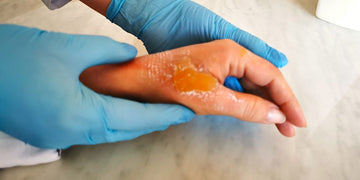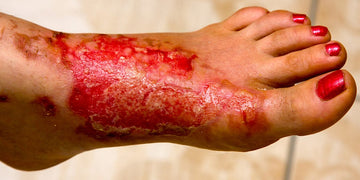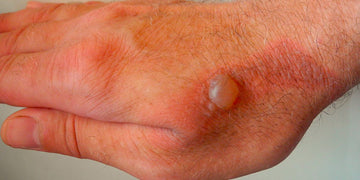Second-degree burns involve the skin and the upper layer of dead skin cells. A first-degree burn would be described as any burn that hurts with redness but doesn’t go as deep into the skin as a second-degree burn. The most common causes are exposure to fire, hot liquids, and chemicals. Since these are exposure types of burns, less water in your body can make it harder to get out of your system. The pain from a second-degree burn may feel like pins and needles, tingling or numbness, and coldness because of exposure.
Should a Second-degree Burn be Covered?
A second-degree burn is a partial-thickness burn. It’s deeper than a first-degree burn but not as deep as a third-degree burn. It damages the top layer of skin and some deeper layers but doesn’t go through to the fat below. Second-degree burns should be kept moist and lightly covered while they heal. This keeps germs out of the wound and prevents infection from setting in. If you don’t have sterile bandages at home, cover your burn with clean gauze or other nonporous material, such as a clean washcloth or paper towels that don’t contain lint or dirt particles. Second-degree burns can be very painful, but they usually aren’t life-threatening.
What are second-degree burn symptoms?
Second-degree burns (thermal burns) usually have blisters that ooze clear fluid when pressed gently with a finger. The skin around the blisters may be red and painful to the touch. Second-degree burns also cause swelling, making them look worse than they are. If you’ve got a burn on your hand or foot, it may also feel numb or tingly. That’s because nerves are damaged and don’t work correctly anymore.
What are common second-degree burn causes?
Second-degree burns can be caused by heat, electricity, or chemicals. The severity of the burn depends on how hot or cold the substance that comes into contact with your skin, how much of your body is exposed to it and how long you were exposed to it. Often causes of second-degree burns affect the hands, arms, and face.
Can you treat a second-degree burn at home?
If the skin isn’t broken, you can treat a second-degree burn home by applying cold compresses for 20 minutes until the pain subsides. You can also use aloe vera gel or burn cream to relieve pain and itching. The burn will eventually scab over after two weeks.
What’s best for treating second-degree burns?
Second-degree burns should be treated at home with cool water, but you should see a doctor if you have a large burn or blisters that break open or don’t heal well. A doctor may prescribe antibiotics and pain relievers to reduce discomfort while healing burns.
Cool water soothes the burn and keeps it clean. Don’t use ice or cold packs, which can cause frostbite if left on too long. If there’s any dirt or debris in the wound, you can gently flush it with cool water from your faucet or shower head. Then apply a topical antibiotic such as Vitastem Ultra and cover it with sterile gauze bandages.
If there’s pain or swelling in the area around your burn, take acetaminophen as directed on its label — no more than eight pills per day for adults, four for kids — until the pain subsides; avoid ibuprofen together because it may make things worse by prolonging bleeding within the injured area.
Should you cover a burn or let it breathe?
Covering a second-degree burn is necessary because it helps prevent further injury by protecting the damaged skin from further damage and bacteria that cause infection. If you don’t have any sterile bandages handy, you can use clean cloths or towels as temporary bandages until you get medical attention.
What is the fastest way to heal a second-degree burn?
The fastest way to promote healing is to stop the burning. Treating second-degree burns starts with cold water in ten-minute intervals until the pain relents is the first line of defense in second-degree burn treatment. After that, follow basic first aid treatment procedures and check it every 24 hours (or more frequently) to be sure there is no infection.
What is first aid treatment for second-degree burns?
Stop the burning process immediately. Cool the burned area with water for about 10 minutes or until the pain stops. Don’t use ice because it can cause damage when applied to a burn; don’t use butter, grease, or lotion because they don’t help with cooling.
Rinsing with cool water for 20 minutes. This will help clean out any dirt or bacteria from the wound and promote healing.
Applying antibiotic ointment keeps the wound moist and prevents infection from developing. You may need prescription antibiotics if the burn area is large or deep enough for germs to enter your body through open wounds.
Cover the burned area loosely with sterile gauze or a clean cloth as soon as possible to prevent shock and further damage. If there’s more than one area of burn on an arm or leg, cover each separately, so they don’t stick together. Don’t wrap too tightly — this could make swelling worse — but leave enough room for circulation underneath the bandage so that healing can take place. Don’t apply ointments or creams before covering a second-degree burn (unless prescribed by a doctor).
Should a doctor see a second-degree burn?
Second-degree burns are usually treated at home. You can apply a cool compress to the burn, which helps reduce pain and swelling. If the burn is on an arm or leg, elevate it above heart level as much as possible. If you have any pain or tenderness in your chest, stop elevating your arm or leg. You may also use over-the-counter (OTC) pain relievers such as acetaminophen (Tylenol). Don’t give aspirin to children because of the risk of Reye syndrome.
A doctor should see a second-degree burn if:
- The burn covers more than 5 percent of your body (excluding hands and feet)
- You have multiple burns over different areas of your body.
- You have severe swelling, blistering, or blistering that covers more than one joint in an arm or leg.
- You have blisters filled with fluid on your hands or feet.
- You have numbness in your hands or feet after being burned.
Do burns heal faster, covered or uncovered?
Second-degree burns do heal faster if they’re uncovered. But the best way to treat them is to cover them with a sterile dressing or bandage and keep them clean, moist, and free of infection.
If burning on your face, hands, or genitals, you’ll probably need stitches to close the wounds and prevent scarring. If you’ve been burned by a chemical, such as acid or bleach, you may have to be hospitalized for treatment of possible chemical burns.
Depending on size and location, second-degree burns can take between seven days and two weeks to heal completely.
How long for a second-degree burn to heal?
It will take at least a week for your second-degree burn to heal. The time will depend on how deep the burn is, how much skin was affected and whether you have other injuries that need attention.
You may also need to take antibiotics if the burn has damaged your skin or if there’s an infection.
Even though the wound will heal over time, there may always be scarring on your burn site.
What happens if a second-degree burn goes untreated?
If left untreated, a second-degree burn can lead to infections and scarring. They can also cause other problems if the injured area is near joints, like fingers or toes because joint movement increases pain and makes healing harder.
The good news is that most second-degree burns heal without further problems if they’re treated properly.
How do you tell if a second-degree burn is infected?
Getting medical attention as soon as possible if you have a second-degree burn is important because the infection can set in quickly and cause serious complications.
Here’s how to tell if your burn has become infected:
- The blisters are filled with pus. The blisters should start to break open after a few days, but if they fill with pus instead of healing, you may have an infection.
- You have a fever above 100 degrees Fahrenheit (37.8 Celsius). Fever is one of the body’s ways of fighting off an infection, so it’s not unusual for someone with an infected wound to feel feverish. If you have a fever and it hasn’t broken within three days, see your doctor or go to an emergency room immediately because this could be a sign of something worse than just an infected wound — like appendicitis or cellulitis.
- You’re feeling weak or nauseous. A high fever can cause exhaustion and nausea, which makes sense since your body is working overtime to fight off the infection in your wound.
Should burns be kept moist or dry?
Skin burns should be kept moist with cool compresses to help relieve pain and decrease swelling. If blisters develop, don’t pop them unless they’re infected.
The most important thing you can do is keep the burn clean and cool. Do not apply butter, ice, or any other substance to the skin. Covering the wound with a clean cloth or dressing is all needed.
Do not break any blisters that form. If a blister does break on its own, leave it alone until it heals naturally.
Does a second-degree burn get worse before it gets better?
It’s common for second-degree burns to have a delayed healing response that may start before you even notice symptoms. This delayed healing response is called a “febrile reaction” and occurs because your body is trying to fight off infection from the burn.
A second-degree burn does not usually get worse before it gets better. But a second-degree burn can become infected with bacteria if treated incorrectly. If you have a second-degree burn, see your doctor immediately so that he or she can check on its progress and ensure it’s healing properly.
Consider Vitastem Ultra for treating second-degree burns
Vitastem Ultra can help provide near immediate relief for burns of the first, second, or third degree at a 10x faster rate than most products (5 to 7 days, if ever). Bacitracin is the active ingredient that quickly combats all bacteria in the application area and is an extremely effective second-degree burn topical antibiotic ointment. Under normal conditions, the human body can house thousands of bacteria types. Most of these bacteria are harmless but may be weak pathogens in damaged tissue. Vitastem Ultra, with its dual-carrier action, rapidly delivers active ingredients into the injury. This allows for faster and more thorough restoration of damaged or weakened tissue.
Our unique formula contains ingredients that surgeons use to promote tissue healing after surgery. This formula is also suitable for post surgery applications where speedy healing is crucial to decrease scar formation.
By utilizing its specialized mixture of ingredients, Vitastem Ultra has developed a delivery system that allows the medicine to be transported at 10x strength and depth more than any other product on the market. This formula stimulates the skin’s walls so that medicine can penetrate the cells at a rate 10x greater than normal. It also kills bacteria quickly, overpowering it and preventing them from developing resistance. Vitastem Ultra, which delivers medicine quickly to the point of need, is why many patients see such rapid results.
In addition to killing harmful bacteria on the skin, Vitastem Ultra also infuses damaged skin cells with vitamin D3 (ascorbic Acid) and vitamin C (vitamin D3), where the skin is left healthy and renewed.
Ask your doctor if Vitastem Ultra is a good fit to treat your skin burn or that of a friend or loved one today.







